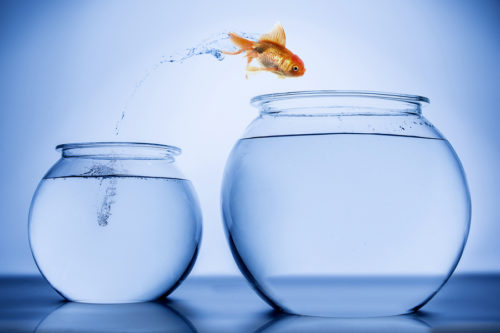Yes, you can keep small fish in a big aquarium. Smaller fish are generally easier to care for and require less maintenance than larger fish. The size of the aquarium should be based on the number and type of fish that will inhabit it: A 10-gallon tank is good for two to three small species such as tetras, guppies or platys; 20 gallons is suitable for four to six goldfish or other larger species; 30 gallons can accommodate eight to ten smaller schooling fish.
To create a healthy environment, provide plenty of swimming space with rocks, plants and other décor items that also give your pet places to hide when they feel threatened. Regular water changes every two weeks will ensure clean water free from excessive nitrates and ammonia levels which can harm the health of your aquatic pets.
- Step 1: Choose the right fish
- When selecting fish for a big aquarium, it is important to choose species that are compatible
- Some species of fish require specific water parameters or tank size and will not do well in an environment that does not meet their needs
- Avoid putting aggressive or large predatory fish in with small peaceful varieties as this could be dangerous for the smaller fish
- Step 2: Provide plenty of space
- For small schooling fish, such as tetras and danios, provide at least 20 gallons of water per 6-10 adult fish so they can swim freely without feeling crowded
- This will help reduce stress levels and increase activity levels among the inhabitants of your aquarium
- Step 3: Add hiding places to the tank
- Smaller species need plenty of cover from predators in order to feel safe when swimming around the tank, so adding live plants or decorations like rocks and driftwood would be beneficial if you plan on keeping small fishes in a big aquarium
- Step 4: Monitor Water Quality Regularly
- Big tanks tend to take longer to cycle than smaller ones due to their greater volume. This means more time between changes is required once you have finished cycling your big tank before introducing any livestock into it! Keeping up with regular maintenance schedules (weekly partial water changes) is essential for maintaining healthy conditions inside your aquarium. Particularly if you plan on keeping delicate small fishes inside it!
Fish Keep
Fish keeping is an incredibly rewarding hobby that allows you to create a beautiful and healthy habitat for aquatic creatures. It requires careful research and planning, as well as regular observation and maintenance of the water quality. Freshwater or saltwater setups can be established with various filtration systems, lighting options, substrate types, decorative items, and of course many different kinds of fish species.
Keeping a fish tank is not only enjoyable but also educational. It teaches us about ecology, biology and chemistry all while providing hours of relaxation.
Do Fish Organs Continue to Grow?
Fish organs, like other organisms’ organs, continue to grow throughout their lives. This means that even the oldest fish may still be growing in size. The growth rate of an individual’s organs is affected by various factors such as nutrition and environmental conditions.
In some cases, a fish’s organ can become so large it affects their ability to swim or feed properly. This is why it is important to make sure your pet fish has adequate space and water quality.
How Many Fish in a Tank?
When considering how many fish to keep in an aquarium, it is important to remember that every species of fish has different space requirements. Generally speaking, the rule of thumb for stocking a tank is one inch of fish per gallon or two gallons per inch of fully-grown adult fish. However, this varies depending on the type and size of the fish you are keeping.
Additionally, it’s important to note that overcrowding can lead to stress and illness among your aquatic inhabitants so be sure not to overstock your tank!
Fish Not Growing
Fish not growing is a common problem faced by aquarists, and it can be caused by too many fish in the tank, poor water quality, inadequate nutrition, or diseases. It’s important to monitor the tank environment carefully and provide suitable levels of filtration and oxygenation for any fish you keep. Ensuring that there are plenty of hiding places for your fish as well as providing appropriate food will also help promote healthy growth.
If none of these solutions work, then it may be time to consult a veterinarian or an experienced aquarist for advice on how to get your fish back up to speed.
How Many Fish in a Tank Calculator?
A fish tank calculator is an invaluable tool for determining the ideal size of your tank and how many fish it can safely accommodate. It takes into account factors such as water volume, type of fish, filtration system, and other environmental elements to determine the optimal number of fish which can be kept in a given aquarium. With this calculator, you’ll know exactly how many fish you should have in your tank to ensure they stay healthy and happy!
Why Do Goldfish Grow to the Size of Their Environment?
Goldfish are known to grow to the size of their environment. This is due to a process called ‘environmental filtering’. When goldfish live in small tanks they don’t have enough room to reach their full potential, so they stay smaller.
On the other hand, when placed in larger environments with plenty of space and resources, goldfish will maximize their growth potential and reach maximum sizes for their species. It’s important that pet owners provide adequate space for fish as well as frequent water changes and healthy diets for them to thrive.
How Many Tropical Fish in a 64 Litre Tank?
For those looking to house tropical fish, it is recommended that you have a minimum of 64 litres (17 gallons) for each fish. This will ensure enough space and water volume for the fish to be comfortable in their environment. To calculate how many tropical fish can live in a 64 litre tank, you should consider the type of fish being housed, as some species require more space than others.
Generally, up to four small-sized tropical fishes could happily reside in a 64 litre tank.
How Many Fish in a 60 Litre Tank?
A 60 litre tank is a great size for keeping fish, but it’s important to be mindful of stocking levels. As a general rule of thumb, you should aim for 1 inch of fish per 4 litres, so for a 60 litre tank that would mean no more than 15 inches worth of adult fish. This can vary depending on the species and size you choose. Some larger or more active species may require less space. So it’s always best to do your research before deciding on how many fish to keep in your aquarium.

Credit: www.kodamakoifarm.com
Can You Put Small Fish in a Big Tank?
Yes, you can put small fish in a big tank! In fact, this is often recommended for novice fish-keepers. When it comes to keeping small fish in an aquarium, size matters.
A large tank provides more stability and consistency than a smaller one does. This means that fluctuations in water temperature or pH levels are less likely to occur as the larger volume of water takes longer to heat up or cool down.
Furthermore, having plenty of swimming space allows your fish to live out its natural behaviors more easily and helps reduce stress levels which can be detrimental to their health and well-being.
Additionally, bigger tanks are generally easier to maintain as they require fewer frequent water changes compared with smaller ones since there is less waste accumulation over time. This also reduces the risk of exposing your petfish to potentially harmful toxins due to build up from decaying organic matter left behind by food debris etcetera.
Finally, if you plan on introducing any other species into the same environment such as corals or invertebrates then having a larger tank will make it much easier for them all coexist without conflicting territory issues arising between them!
What Happens If a Fish is Too Big for a Tank?
If a fish is too big for its tank, it can become stressed and develop health problems like fin rot or disease. The stress of being confined in a cramped space can also cause the fish to become aggressive and attack other fish in the tank.
Additionally, an undersized aquarium may not provide enough oxygen or filtration to keep water quality at safe levels for such a large fish.
Furthermore, if the tank is too small, there would be no room for swimming around comfortably; this lack of exercise could lead to physical weakness and poor nutrition. In extreme cases, an oversized fish may even grow larger than its tank’s surface area which could prevent it from getting any oxygen at all! If you think your fish might be too big for their home, you should consider upgrading them to a larger aquarium with more space so that they don’t suffer from any of these issues.
Will My Big Fish Eat My Little Fish?
No, your big fish will not eat your little fish. While it can sometimes be difficult to tell the size difference between two fish in a tank, it is important to know that large and small species of fish should never inhabit the same tank. Adding an oversized or aggressive species of fish into a smaller aquarium with more delicate and docile types can cause serious harm or even loss of life for the other occupants.
Bigger varieties are usually much faster swimmers than their smaller counterparts and may try to catch them as prey if given the chance. Even if you think they look similar in size, there could still be enough of a discrepancy for trouble to occur. To avoid any potential danger, make sure that all new additions to your aquarium are appropriate sizes for its inhabitants and keep an eye out just in case!
Does Tank Size Affect How Big a Fish Will Grow?
The size of a fish’s tank can have an impact on how large it will grow. Fish need to be kept in tanks that are appropriately sized for their species, as too small of a tank may not provide enough space and resources for them to reach their full potential. While the exact amount of space needed varies from species to species, generally speaking, larger tanks tend to allow for more growth than smaller ones due to increased water volume and greater access to food sources.
Additionally, overcrowding can cause stress which can lead to stunted growth or even death in some cases.
Furthermore, if the oxygen levels in the water are too low or ammonia concentrations are high due to inadequate filtration systems or overfeeding, this can also significantly limit growth rates.
For these reasons, it is important that hobbyists pay close attention when selecting a tank size based on their desired fish type; doing so may help ensure that they get optimal results with respect to its adult size and health overall!
Top 7 small fish, that get really BIG!
Conclusion
Overall, the size of your aquarium when it comes to keeping small fish is an important factor. Smaller fish require a smaller tank and more frequent water changes while larger tanks can accommodate bigger species that produce more waste. If you want to keep small fish in a big aquarium, make sure you have good filtration and perform regular maintenance.
With adequate care and research, having both small and large fish in one tank can be done successfully!
